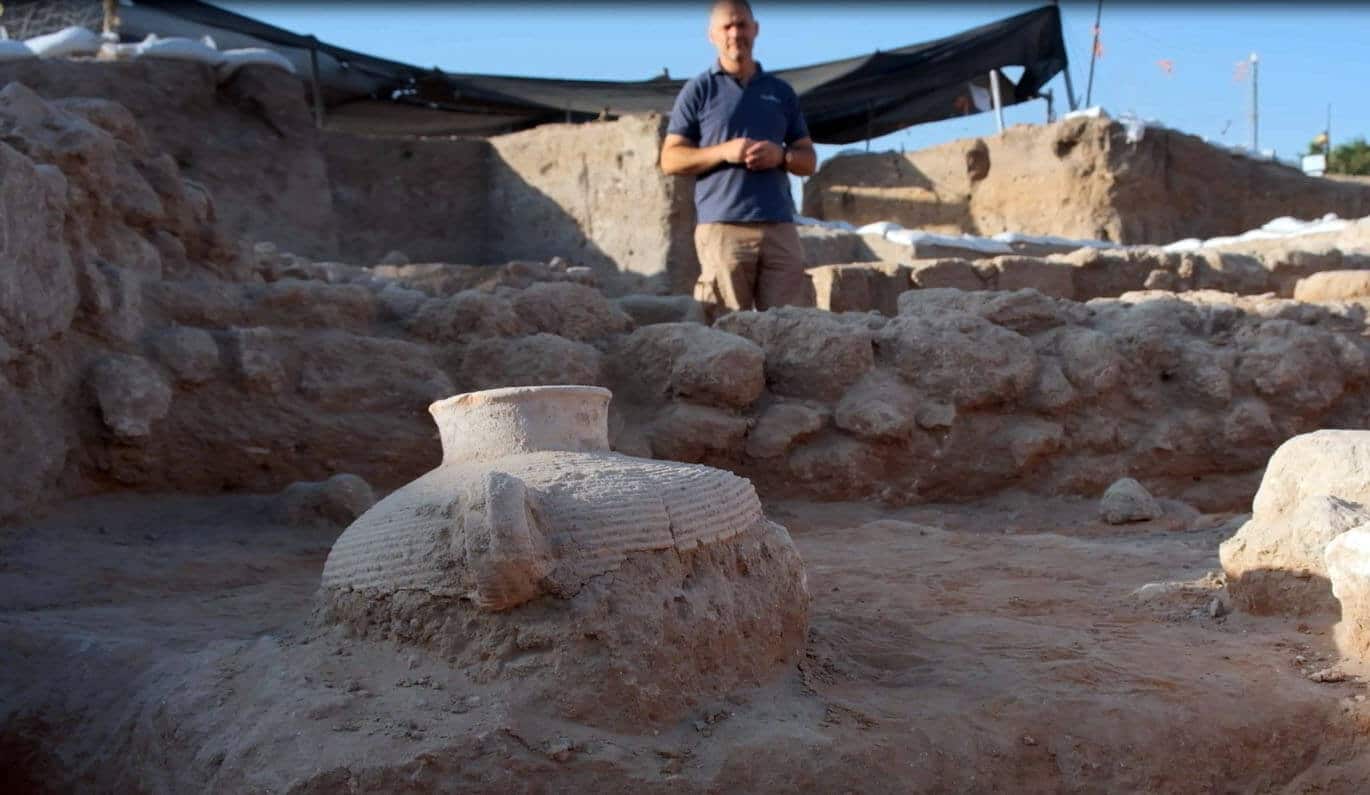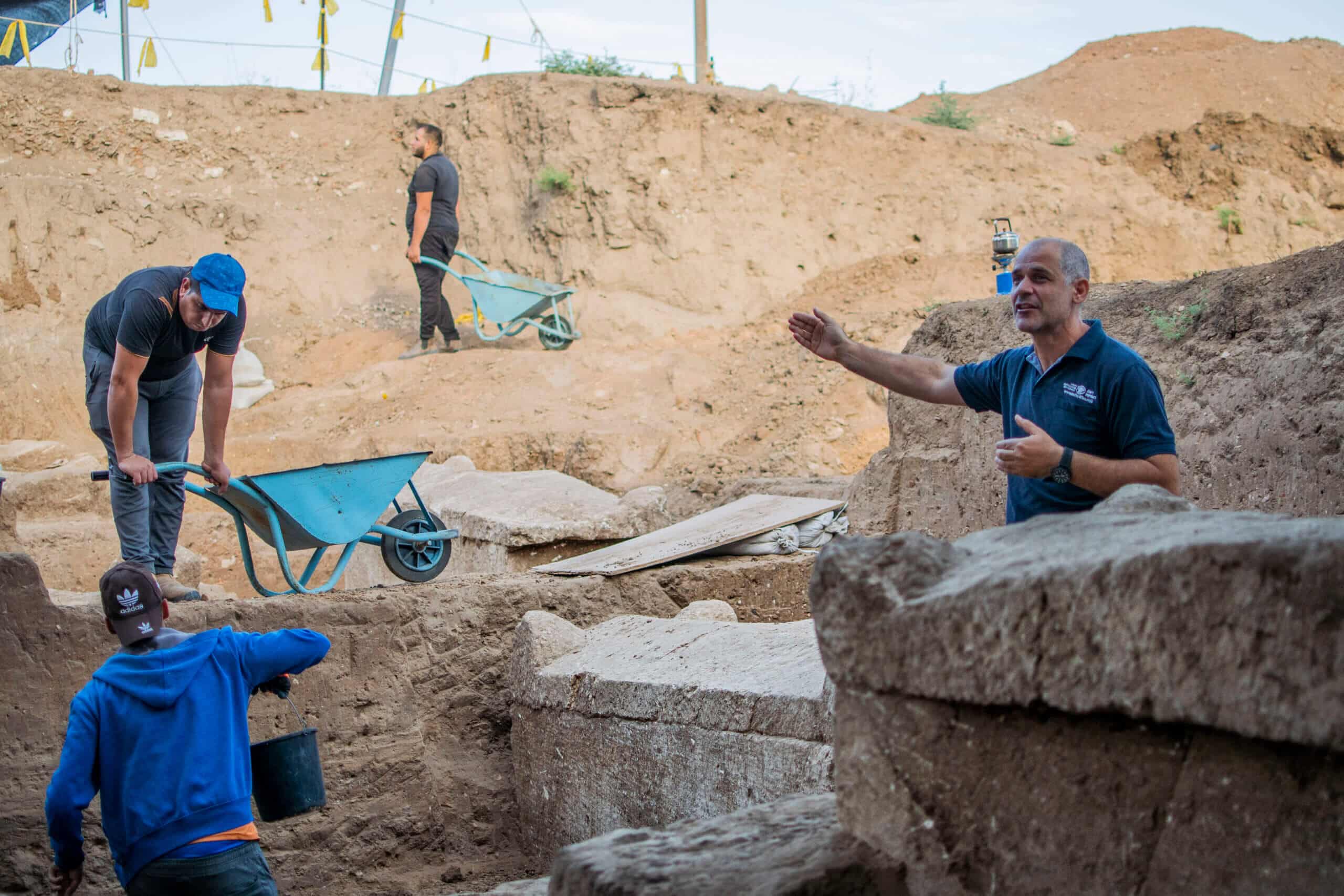*The discovery was made in the huge excavation of the Antiquities Authority in Yavne, funded by the Israel Lands Authority and in cooperation with the Yavne municipality on the occasion of the expansion of the city. Fragments of stone vessels made of Kirton were discovered in the building, indicating a Jewish presence.

The excavation by the Antiquities Authority in Yavneh reveals evidence of the life - and also the death - of the residents of Yavneh during the Sanhedrin - the 1st and 2nd centuries AD. The excavation revealed, for the first time, the remains of a building dating back to the days of the Sanhedrin, where limestone cups were discovered, testifying to a Jewish presence and the preservation of the laws of impurity and purity in the place. In the excavation, which was conducted before the expansion of the city, at the initiative of the Israel Lands Authority and in cooperation with the municipality of Yavne, a large-scale cemetery from those days was also discovered. Near this excavation area, a huge factory for the production of wine from the Byzantine period was recently uncovered. This week - the Hanukkah holiday, there are tours of the excavation with advance registration, as part of the Israel Heritage Week.
"The discovery of the findings from the days of the Sanhedrin is very exciting," they say Pablo Betzer and Dr. Daniel Varga, the managers of the excavation on behalf of the Antiquities Authority. "This is a direct greeting from the time when the Jewish leadership collected the fragments after the destruction of the Temple, discovered a birch tree, and there - began to rehabilitate the Jewish people."
The excavation revealed for the first time a building of an industrial nature, dating to the 1st-3rd centuries AD. On its floor, several fragments of stone vessels were discovered, of the type known as "measuring cups" - vessels that do not receive impurity, identified with the Jewish population of the late Second Temple period and the 2nd century AD.

At a distance of only 70 meters from the building, an impressive cemetery was revealed. "We found dozens of graves arranged in an unusual way, in rows and at fixed distances, which may indicate the existence of a "Kedisha Society" - some entity that was responsible for the burials," they say Betzer and Dr. Varga. "The graves have different shapes: some are made as coffins (sarcophagi), most are made of stone, and one is made of lead." The managers of the excavation add that "according to the location of the cemetery, it can be assumed that it was established outside the city limits, in accordance with Jewish law and Roman law. But were Jews or pagans buried here? It is too early to determine, because no identifying ethnic marks appear on them. The historical description and the archaeological findings make it possible to raise, cautiously, the possibility that these are graves of the Jewish community of the city. If this hypothesis is correct, then it is possible that at least in some of the graves, perhaps in the nicest of them, the sages of Yavneh, contemporaries of Rabbi Yohanan ben Zakkai, Rabbi Akiva and Rabbi Gamaliel, were buried."
Another surprising find was discovered during the excavation: more than 150 glass vials were discovered lying above the graves. According to Dr. Yael Gorin - Rosen, head of the glass branch at the Antiquities Authority, "The vials were probably used to store valuable liquids, such as fragrant oils. About half of them were produced locally and the other half - imported from Alexandria in Egypt. Such vials are discovered both in excavations in Jewish graves, and in pagan graves, from the 1st century to the beginning of the 3rd century AD. Placing the vials outside the graves in Yavne and not inside them, as was customary, is a mystery."
According to Eli Escozido, director of the Antiquities Authority, "The Yavneh excavation is a mega-excavation of the Antiquities Authority that extends over dozens of dunams, with the participation of hundreds of workers and dozens of staff members and permanent experts. As a body that seeks to connect the public to the heritage of the land, we involve in the excavation hundreds of teenagers, preparatory school students and the residents of Yavne. Our archaeologists are doing sacred work in uncovering unknown chapters in the history of the land, while working hard in heat and cold. I welcome the cooperation with the Israel Lands Authority and the Municipality of Yavneh, which will allow the presentation of some of the impressive excavation findings to the general public and their integration into an archaeological park."
Jacob Quint, director of the Israel Land Authority, He said that "the treasures hidden in the soil are revealed thanks to the extensive investment of the Israel Land Authority in financing the archaeological excavations in Yavneh. Rami promotes, as part of the umbrella agreement with the Yavne municipality, the construction of a huge project in the area of the Yavne Mizrah Sorek project (Tamel 1049). In the plan, 12,500 units and 450 thousand square meters of commerce and employment will be built. The plan includes the doubling of the railway and construction above a train station. As part of the preliminary work for the development of the plan, the Israel Lands Authority is investing approximately NIS 200 million in the works of the Antiquities Authority, which enable the uncovering of the archaeological finds, their investigation and preservation for the benefit of future generations."
Zvi Gov-Ari, mayor of Yavne, says that: "The importance of Yavneh's position in the history of the Jewish people is being further substantiated today. We must remember that with the destruction of the Second Temple, the flame of Judaism was rekindled in our city, and without the establishment of the Sanhedrin in Yavneh, it is doubtful whether the survival of the Jewish religion would have been guaranteed. Yavneh of today will continue to develop, when the principle that guides us is that the present must have firm roots, while the future will be built as the pooling of the experience of the past, the present and the development of future generations."
In ancient times, Yavneh was one of the most important cities in the south of the coastal plain. During the Hasmonean period, it played an important role in the struggle between the Maccabean army and the Seleucid (Greek) government, and is mentioned many times in the writings of Josephus.
Towards the end of the Second Temple period, Yavneh was a mixed city, most of whose inhabitants were Jews. According to the descriptions in the literature of the Sages, before the destruction of the Second Temple, Rabbi Yohanan ben Zakhai escaped from the besieged Jerusalem, and he convinced the Roman Emperor Vespasian to allow him to re-establish the Sanhedrin in Yavneh. In this situation, the famous saying of Rabbi Ben Zakhai was said: "Give me Yavneh and her wisdom."
After the destruction of the Temple and until the Bar Kochba revolt, Yavneh was the most important Jewish spiritual center in the Land of Israel. Rabbi Yohanan ben Zakhai, followed by Rabbi Gamliel, led the Sanhedrin and the presidency in Yavneh, restored the life of the Torah in the Land of Israel and established regulations suitable for the reality without a temple. It can be said that in its construction the foundations of Judaism as we know it today were laid.
More of the topic in Hayadan:
- A huge and impressive wine factory was uncovered in Yavne, the largest known in the world from the Byzantine period
- AI economy in antiquity: roads, highways and infrastructures in the Roman period
- Economy 16 Chapter XNUMX: Under the Romans after the destruction of the Second Temple: Small or large farm
- From the end of the Great Rebellion to Ben Kusba's Rebellion (Bar Kochba): The Big Brother intervenes
- Opinion: What is the history?

3 תגובות
First - to this day it is not known whether the Jewish settlement in Yavne was on a free-choice basis or whether it was forced. The sources leave no basis for one option or another. It is surprising, although not always surprising, why the sarcophagi are not decorated with inscriptions similar to those in Beit Shaarim, for which some speculations have been made, and for that it is a great shame. In any case, it is worth noting that Yavne was known for its economic foundation, and it was like Yamaniya, it was connected to the port of Yamaniya Yam and that a Roman garrison had been stationed near it since the eve of the Great Rebellion. My guess is that the word port is a distorted product of the Greek word liman (a full and purple shriek), and it definitely has kaba for "right hand".
The truth emerged to her through means that are preserved but it is not certain that they gather in graves and houses.
Vials you said? To preserve exotics? Perhaps as I wrote above for the preservation of uncounted currents.
Maybe what you think about Yavne was created as a contrast to what happened in Israel. Therefore, if there was a government based in the Temple where they would sell and exchange money in its territory, it is possible that in the city they tried to look for anything else that would not be like this but would not deviate from what is accepted. In other words, the reality of Yavneh was from a path that they managed to find even if its end is not yet described and it is good that it is so. The ending that preceded was also not a great bargain. A type of what was decided by a council that was loosely connected to the people. The religious leadership since ancient times did not aspire to rule so that when necessary the period must be examined. We responded to the challenge.
And what about the carcasses? Skeletons found? Are they trying to extract d.na. And look for the connection to today's Jews? Of course there is not and will not be any genetic connection. They were all mega-pagans, idolaters and a side stream of what the nation of Israel developed. It is doubtful whether these figures even existed - Rabbi Yohanan ben Zakhai and Rabbi Gamaliel